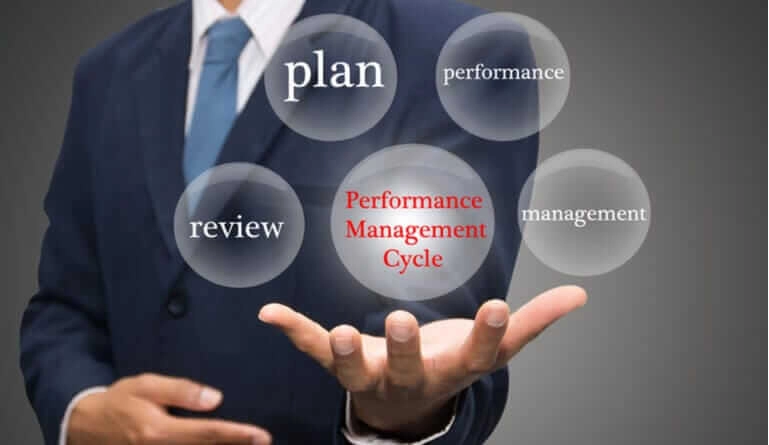The performance management cycle is an essential component to achieve organizational success as well as a competitive edge. It is a recurring phenomenon in every organization in which employees are evaluated annually.
So, why is it important?
By developing a performance management cycle plan, a business ensures that organizational goals are going forward by maximizing the output of their employees and concretely tracking the performance of every employee.
By following the cycle, a business can also continuously revisit its own structural goals, allowing for a quicker response to the changing market forces. And this flexibility also means a boost in the organization’s competitiveness.
Employees also benefit— through collaboration and the support from their management team, employees see that they are a valued member. Their skills are being enhanced and used in meaningful ways. Plus, there is a reward for their hard work. These all help to increase job satisfaction and improve retention.
The 4 Stages of the Performance Management Cycle
The performance management cycle is divided into 4 strategic phases— planning, monitoring, reviewing and rewarding. This process is focused on setting employee goals that are aligned with the strategic objectives of the business. These four stages are completed over the course of one business year with the cycle starting again in the following year. Check over here to have a better understanding of each phase:
1. Planning
Being the first stage, planning is the foundation of the whole performance management cycle. It is carried out at the start of each business year.
During this stage, managers will develop an overall plan for the company. They will identify future performance gals for every employee in terms of behaviors, targets, and actions as well as a development plan to enhance employees’ skills.
Setting Goals
In this phase, every employee’s goals are set for the performance period. This one is a collaborative effort between the employee and their manager or supervisor.
By involving the employees in this stage, managers can help them understand the goals of the business and the what, why and how of the things that need to be done. This also boosts the commitment and motivation of an employee in achieving the goal.
S.M.A.R.T Goals
The goal needs to challenge an employee but should also be achievable. Thus, it needs to be a SMART goal.
- SPECIFIC: A goal needs to be clear and detailed, stating the exact performance level expected.
- MEASURABLE: A goal should have a measurable indicator so you can assess the progress and to ultimately determine if the goal has been accomplished.
- ACHIEVABLE: A goal needs to challenge and employee and stretch their skills and abilities, however, it should be virtually possible to attain.
- RELEVANT: A goal needs to be connected to the company’s goals as well as being relevant to an employee’s responsibilities and duties.
- TIME-BOUND: A goal needs to state the “when” of the achieved results.
Don’t Forget the Employee Development Plan
The first stage is also a great opportunity to identify development and training requirements and opportunities for employees. Thus, this stage should also include the construction of a personal development plant, addressing the skills and strengths that an employee should develop in order to achieve goals.
2. Monitoring
Regular monitoring is an orderly way to determine whether the methods or plans to achieve the goals are indeed working.
The monitoring stage will not be effective though if it is only done once or twice throughout the year. Thus, it is highly advised that managers meet with employees on a quarterly or monthly basis.
Organizational changes or some business conditions can occur, affecting an employee’s ability to follow the original plan or achieve the goals. Therefore, an adjustment to the performance plan of an employee may be needed.
Implementing Periodic Meetings
Regular meetings need to be implemented in order to ensure continuous monitoring of how employees are doing as well as identifying and resolving problems early. It also provides the opportunity of getting feedback.
So, make sure to schedule a regular meeting in order to determine:
- The employee’s performance to date
- What has been accomplished
- If the goals are on track for completion
- If any support is needed
- If there are any issues
- If the goal needs some revising
3. Reviewing
Next, we have performance reviewing. This is usually done on an annual basis when the finals results of an employee’s performance are reviewed.
This phase is a collaborative effort and designed to allow the manager or supervisor and employee to evaluate how well achievements have met the goals set during the first stage.
The Review Process
During this phase, both managers and employees will review the performance. Employees will review their accomplishments from their own perspective via a self-assessment process. This gives an employee the opportunity to see just how they met their objectives or exceeded expectations.
The evaluation needs to include questions like:
- Was the goal relevant to the company’s objectives?
- Was the original goal realistic?
- How well did an employee complete his tasks?
- Did the employee obtain useful skills or experience?
- Did the company offer enough support to achieve the set goal?
- What parts of this process could be improved or streamlined?
If there have been any issues in performance during the year, this is also the stage where they can be brought up. However, it is recommended that if such issues have arisen, then possible solutions should also be presented.
This is also the perfect time in which future developments can be discussed, as well as compensation increases or bonuses.
4. Rewarding
The last phase of the performance management cycle is rewarding. Rewarding is providing incentives to the employees for all their performance and acknowledging the contribution to the company’s success.
It is a crucial stage that should never be overlooked since it is the very thing that drives employee motivation.
If employees are not rewarded properly for their good performance or contributions to the company for a year, they will lose the motivation to strive better and perform more efficiently in the following year. Also, they will be less inclined to exceed or even reach their goals if they feel that there is no benefit to them.
They can lose their faith in their company, feel that their skills and talents are unappreciated and start searching for a new job.
In contrast, when management fairly rewards their employees for all their hard work and gives them recognition for their achievements and effort, they are ensuring that their employees will continue to strive and work hard, performing efficiently to achieve the company’s goals and success.
The rewards need to be merit-based. An employee will recognize who amongst them has put in hard work and effort. And if they see a co-worker rewarded without a good cause, then they could lose their motivation.
On the contrary, when an employee sees a high-performer get a nice reward, that employee will see the value of putting in an extra effort next time.
Some of the rewards that can be offered include:
- Special projects
- Compensation increase
- One-time bonus
- Promotion
- Increased vacation time
- Company-wide acknowledgment
- Positive written review
After this stage, the employees and management team can choose to meet again, one final time for the year, to review the performance management cycle as a whole. This brings the opportunity to talk about certain issues or challenges that might have arisen in the process and start talks about the goals for next.
Then, the cycle begins again.
***
Maxwell Donovan works in the conference production industry. His primarily works to discover the right group of delegates for business gatherings. You can find him on Twitter, Facebook and at Corptive.com.




